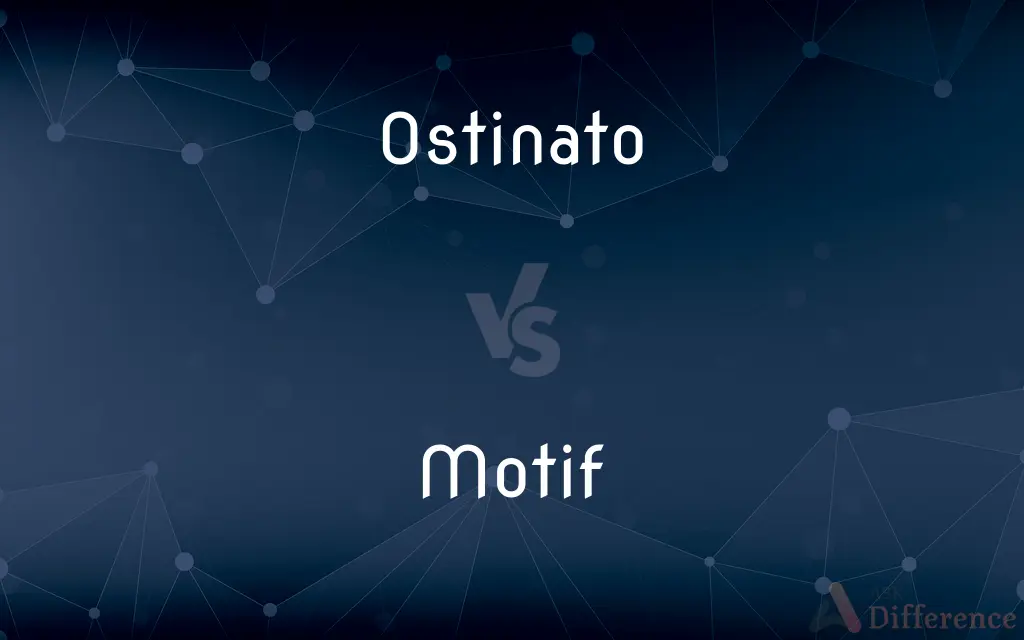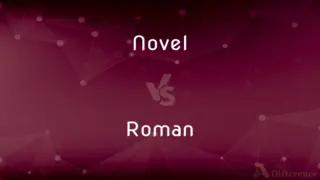Ostinato vs. Motif — What's the Difference?

Difference Between Ostinato and Motif
ADVERTISEMENT
Compare with Definitions
Ostinato
In music, an ostinato (Italian: [ostiˈnaːto]; derived from Italian word for 'stubborn', compare English 'obstinate') is a motif or phrase that persistently repeats in the same musical voice, frequently in the same pitch. Well-known ostinato-based pieces include both classical compositions, such as Ravel's Boléro and the Carol of the Bells, and popular songs such as Donna Summer and Giorgio Moroder's "I Feel Love" (1977), Henry Mancini's theme from Peter Gunn (1959), The Who's "Baba O'Riley" (1971), and The Verve's "Bitter Sweet Symphony" (1997).Both ostinatos and ostinati are accepted English plural forms, the latter reflecting the word's Italian etymology.
Motif
A recurrent thematic element in an artistic or literary work.
Ostinato
A short melody or pattern that is constantly repeated, usually in the same part at the same pitch.
Motif
A dominant theme or central idea.
Ostinato
(music) A piece of melody, a chord progression, or a bass figure that is repeated over and over as a musical accompaniment.
ADVERTISEMENT
Motif
(Music) A short rhythmic or melodic passage that is repeated or evoked in various parts of a composition.
Ostinato
A musical phrase repeated over and over during a composition
Motif
A repeated figure or design in architecture or decoration.
Motif
A recurrent pattern either of molecular sequence, usually of nucleotides or amino acids in proteins, or of molecular structure that usually corresponds to specific biological activity.
Motif
A recurring or dominant element; an artistic theme.
See how the artist repeats the scroll motif throughout the work?
Motif
(music) A short melodic or lyrical passage that is repeated in several parts of a work.
Motif
A decorative figure that is repeated in a design or pattern.
Motif
(dressmaking) A decorative appliqué design or figure, as of lace or velvet, used in trimming.
Motif
(crystallography) The physical object or objects repeated at each point of a lattice. Usually atoms or molecules.
Motif
(chess) A basic element of a move in terms of why the piece moves and how it supports the fulfilment of a stipulation.
Motif
(biochemistry) In a nucleotide or aminoacid sequence, pattern that is widespread and has, or is conjectured to have, a biological significance.
Motif
Motive.
Motif
In literature and the fine arts, a salient feature or element of a composition or work; esp., the theme, or central or dominant feature;
This motif, of old things lost, is a favorite one for the serious ballade.
The design . . . is . . . based on the peacock - a motif favored by decorative artists of all ages.
Motif
A decorative appliqué design or figure, as of lace or velvet, used in trimming; also, a repeated design.
Motif
A design that consists of recurring shapes or colors
Motif
A theme that is elaborated on in a piece of music
Motif
A unifying idea that is a recurrent element in a literary or artistic work;
It was the usual `boy gets girl' theme
Share Your Discovery

Previous Comparison
Renga vs. Haiku
Next Comparison
Novel vs. Roman













































